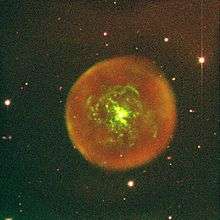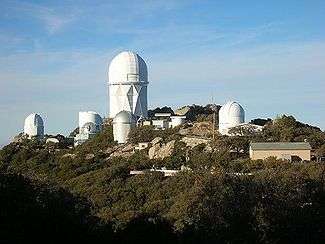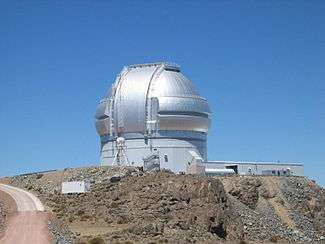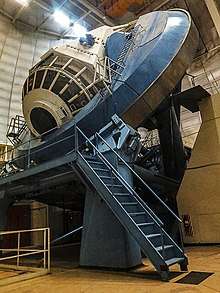National Optical Astronomy Observatory
The National Optical Astronomy Observatory (NOAO) is the United States national observatory for ground-based nighttime ultraviolet-optical-infrared (OUVIR) astronomy. The National Science Foundation (NSF) funds NOAO to provide forefront astronomical research facilities for US astronomers. However, professional astronomers from any country in the world may apply to use the telescopes operated by NOAO under the NSF's "open skies" policy. Astronomers submit proposals for peer review to gain access to the telescopes which are scheduled every night of the year for observations (with the exception of Christmas and New Year's Eve). The combination of truly open access and the merit based science proposal process makes NOAO unique in the world.
.jpg)

The NOAO headquarters are located in Tucson, Arizona and are co-located with the headquarters of the National Solar Observatory. The NOAO is operated by the Association of Universities for Research in Astronomy (AURA), under a cooperative agreement with the NSF.
Many famous US telescopes, such as the Hale telescopes in California and the Keck telescopes, were built by citizen benefactors, not by the United States government or Universities. Many of these do not have the same public access criteria as the United States government supported telescopes, which are financially supported by public funds. Also, many telescopes and programs and NASA, while sometimes having some connections are also separate from the activities and funding of the national observatory, including telescopes like the Hubble Space Telescope.
National Optical-Infrared Astronomy Research Laboratory
.jpg)
Starting on October 1, 2019 the NOAO is operated under the NSF as the National Optical-Infrared Astronomy Research Laboratory.[1] This organization includes the following: Cerro Tololo Inter-American Observatory, the Community Science and Data Center, Kitt Peak National Observatory, access to the Gemini Observatory, and the Large Synoptic Survey Telescope.[1] The United States public institution for radio astronomy is covered by the National Radio Astronomy Observatory. This is separate from the more popularly known NASA, which also operates some telescope programs. Many famous U.S. telescopes such as the Hale telescopes were funded privately or are supported by private organizations.
The NOAO was founded in 1982 when Kitt Peak and CITO were united.[2] For 2020 the budget of overall organization was around 20 million USD.[2]
NOAO Telescopes
NOAO operates world class research telescopes in both the northern and southern hemispheres. These telescopes are located at Kitt Peak and Cerro Tololo in the US and Chile, respectively. Complemented with similar astronomical instruments, the two sites allow US astronomers to make observations over the entire sky. Instrumentation includes optical to near infrared wavelength (0.4 to 5 micrometres) cameras and spectrometers.
Cerro Tololo Inter-American Observatory (CTIO)
CTIO has a base and office facility in the seaside town of La Serena, Chile. The CTIO telescopes are located some 70 km inland in the foothills of the Chilean Andes. Access to the observatory is made through the picturesque Elqui Valley.
Telescopes at CTIO include the Victor M. Blanco Telescope (named after astronomer Victor Manuel Blanco in 1995) which employs a wide-field of view CCD (Charge-coupled device), a wide field of view near infrared imager (1-2.5 micrometres) and a multi-object fiber fed spectrograph working at visible wavelengths.
The Blanco 4m played the central role in discovery of Dark Energy,[3][4] a poorly understood component to the universe which is currently causing the universe to accelerate in its expansion. The Blanco began hosting a new 3-degree field of view camera called the Dark Energy Camera, also known as DECam, in 2012. This camera is being built at Fermilab in Chicago, USA, and will be operated by CTIO. This instrument was built to execute the Dark Energy Survey, an undertaking to image a large part of the sky to faint light levels, detecting galaxy large scale structure as a function of look back time to shed light on the nature of dark energy.
CTIO operates, and is a partner in the 4.1m Southern Astrophysical Research Telescope (SOAR). SOAR concentrates on high angular resolution observations and will soon deploy an adaptive optics module to help support such observations.
Kitt Peak National Observatory (KPNO)
KPNO is located near Tucson, AZ, USA. The mountain, Kitt Peak, is part of the tribal lands of the Native American people the Tohono O'odham. The mountain has been leased from the Tohono O'odham since 1958. The native name for the mountain is "loligam" which means manzanita.

The observatory was established in 1958, and its largest telescope, the Nicholas Mayall 4m was dedicated in 1973. The Mayall played a key role in the discovery of dark matter though observations of external galaxies which showed that the galaxies rotated faster than they should have if the motion were due only to the mass in stars seen in visible light images.
A new wide field imager working at near infrared wavelengths (NEWFIRM) has been deployed to advance studies of galactic star formation, cosmology, and the structure and evolution of galaxies.
NOAO Gemini Science Center (NGSC)
NOAO also manages US participation in the international Gemini Observatory. Gemini is a partnership of Argentina, Australia, Brazil, Canada, the United Kingdom, and the United States. The US holds a 50% share of the project (funded by the NSF) which provides public access time on each of Gemini's two 8m telescopes. One telescope is located near CTIO in Chile, and the other is located on the island of Hawaii.

Gemini is the only facility available to all US astronomers on a permanent basis for large aperture science. Large apertures are typically taken to be between 6.5m and 10m. Gemini provides near infrared, mid infrared (10-20 micrometre), and optical imaging and spectroscopy in both the southern and northern hemispheres.
One of Gemini's strengths is high angular resolution imaging accomplished through laser guide star adaptive optics. These facilities are already making an impact. For example, Gemini astronomers, along with their collaborators at the 10m W. M. Keck Observatory, recently announced the first images of an extra solar system with three detected planets circling their parent star, an A-type star known as HR 8799.[5]
Large Synoptic Survey Telescope (LSST)
NOAO is a founding partner in the LSST project. The LSST is an 8m class telescope which will change the way some astronomers do science. More like a large physics program, LSST will run its own experiment and provide data to the LSST community in the form of images and astronomical catalogs. LSST will have a dedicated wide field imager, and the telescope will cover the entire sky visible from the southern hemisphere approximately every week. By repeating the observations over and over for ten years, the LSST will produce a very deep image of the sky, but it will also detect large numbers of astronomical objects which vary in brightness daily or on longer time scales. LSST scientists will analyze, or "mine", the LSST data rather than go to the telescope to make their own observations.
LSST is currently in the pre-construction phase. During this phase, NOAO is responsible for design & development of the LSST telescope system and site facilities. LSST will be located on Cerro Pachón in Chile, near the Gemini and SOAR telescopes. It will share operational infrastructure with Gemini, SOAR, and NOAO, both on the mountain and in La Serena.
A System of US Telescopes

At the beginning of the new millennium, the National Academy of Sciences published its report on Astronomy and Astrophysics in the coming decade. Among other high priorities, the committee responsible for the report concluded:[6]
U.S. ground-based optical and infrared facilities...should...be viewed by the National Science Foundation (NSF) and the astronomical community as a single integrated system drawing on both federal and nonfederal funding sources. Effective national organizations are essential to coordinate, and to ensure the success and efficiency of, these systems. Universities and independent observatories should work with the national organizations to ensure the success of these systems.
NOAO has worked very hard with the US community in the ensuing years in developing this System. A clear success story is the public access to non-federal large aperture telescopes through the NSF funded and NOAO managed Telescope System Instrumentation Program (TSIP). This program, accomplished with the enthusiastic support of the US non federal observatories, supplies the broad US community with some 70 nights of observing time per year.
This System goal was further reiterated by the NSF Senior Review in 2007 when it reviewed the full suite of NSF ground-based astronomy facilities.[7] NOAO continues to work on behalf of the community to effectively shape the System and gain steady, state-of-the-art research capabilities of all apertures for open, merit based science.
A future major capability for the US system is an Extremely Large Telescope with diameter up to 30 meters. Two private consortia are currently working on such projects which may be operational before the end of the decade. These are the Thirty Meter Telescope and Giant Magellan Telescope. NOAO is working with both projects in planning for potential future involvement of the broad US community through operational support funding by the NSF.
See also
- Other Optical Observatories in Chile
- Europe's Very Large Telescope & La Silla Observatory
- Carnegie Institution of Washington's Las Campanas Observatory
- The Magellan telescopes
- Other Optical Observatories in Arizona
- World Wide Observatories
- List of observatories
- Victor Manuel Blanco
- Mark Trueblood
- Dara Norman
References
- "NSF's national optical-infrared astronomy research laboratory launched".
- "FY 2019 NSF Budget Request to Congress" (PDF).
- Perlmutter, S.; Aldering, G.; Goldhaber, G.; Knop, R. A.; Nugent, P.; Castro, P. G.; Deustua, S.; Fabbro, S.; Goobar, A.; Groom, D. E.; Hook, I. M.; Kim, A. G.; Kim, M. Y.; Lee, J. C.; Nunes, N. J.; Pain, R.; Pennypacker, C. R.; Quimby, R.; Lidman, C.; Ellis, R. S.; Irwin, M.; McMahon, R. G.; Ruiz‐Lapuente, P.; Walton, N.; Schaefer, B.; Boyle, B. J.; Filippenko, A. V.; Matheson, T.; Fruchter, A. S.; et al. (1999). "Measurements of Ω and Λ from 42 High‐Redshift Supernovae". The Astrophysical Journal. 517 (2): 565–586. arXiv:astro-ph/9812133. Bibcode:1999ApJ...517..565P. doi:10.1086/307221. S2CID 118910636.
- Riess, Adam G.; Filippenko, Alexei V.; Challis, Peter; Clocchiatti, Alejandro; Diercks, Alan; Garnavich, Peter M.; Gilliland, Ron L.; Hogan, Craig J.; Jha, Saurabh; Kirshner, Robert P.; Leibundgut, B.; Phillips, M. M.; Reiss, David; Schmidt, Brian P.; Schommer, Robert A.; Smith, R. Chris; Spyromilio, J.; Stubbs, Christopher; Suntzeff, Nicholas B.; Tonry, John (1998). "Observational Evidence from Supernovae for an Accelerating Universe and a Cosmological Constant". The Astronomical Journal. 116 (3): 1009–1038. arXiv:astro-ph/9805201. Bibcode:1998AJ....116.1009R. doi:10.1086/300499. S2CID 15640044.
- Marois, C.; MacIntosh, B.; Barman, T.; Zuckerman, B.; Song, I.; Patience, J.; Lafreniere, D.; Doyon, R. (2008). "Direct Imaging of Multiple Planets Orbiting the Star HR 8799". Science. 322 (5906): 1348–1352. arXiv:0811.2606. Bibcode:2008Sci...322.1348M. doi:10.1126/science.1166585. PMID 19008415. S2CID 206516630.
- Astronomy and Astrophysics in the New Millennium, Astronomy and Astrophysics Survey Committee, Board on Physics and Astronomy–Space Studies Board, Commission on Physical Sciences, Mathematics, and Applications, National Research Council, NATIONAL ACADEMY PRESS, Washington, D.C.
- FROM THE GROUND UP: BALANCING THE NSF ASTRONOMY PROGRAM; https://www.nsf.gov/mps/ast/seniorreview/sr-report.pdf